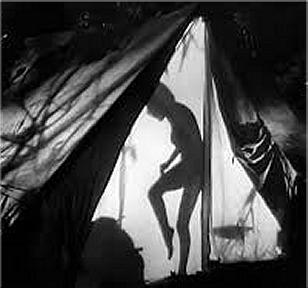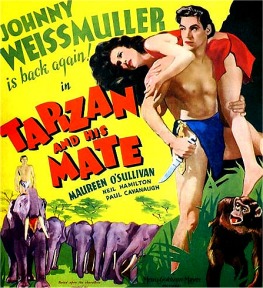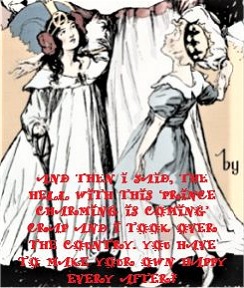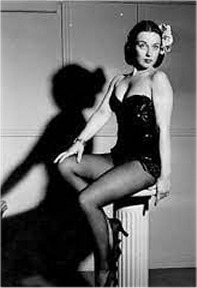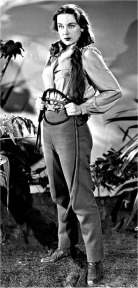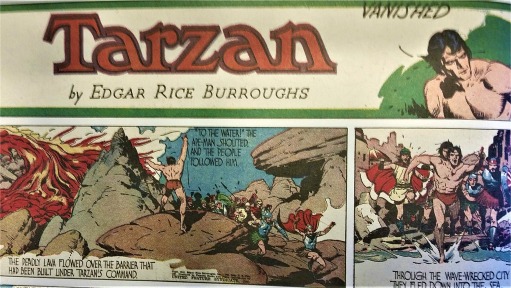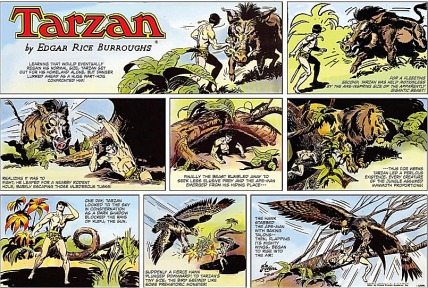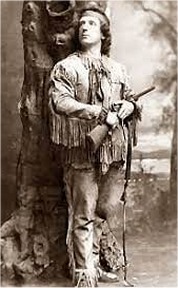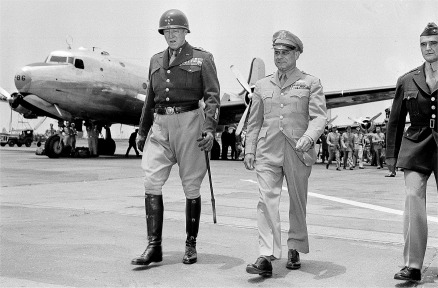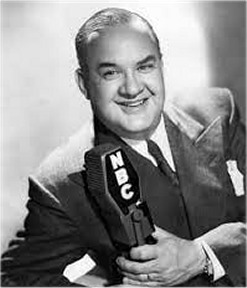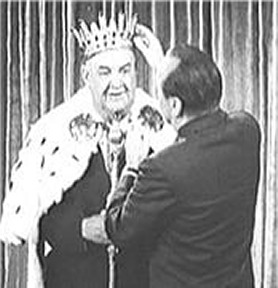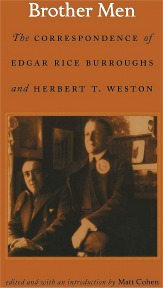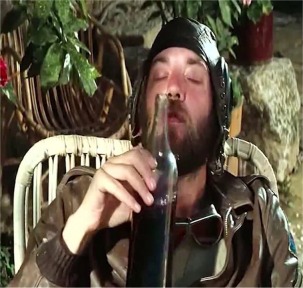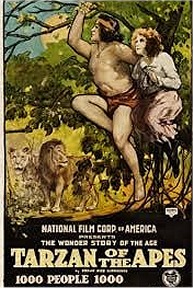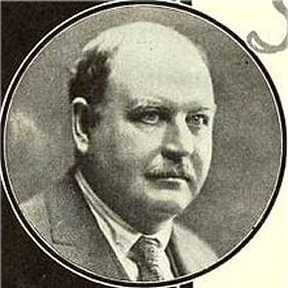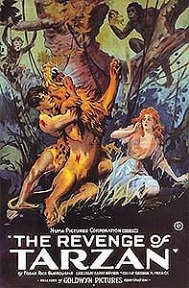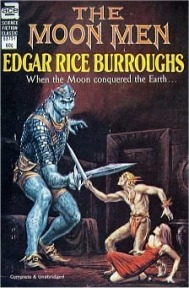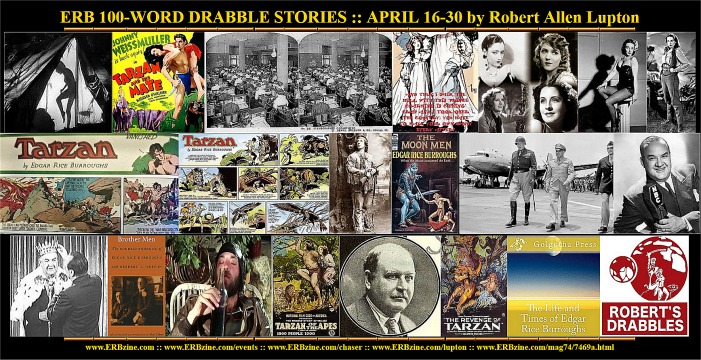
Official Edgar Rice Burroughs Tribute and Weekly Webzine Site Since 1996 ~ Over 15,000 Webpages in Archive Volume 7469a  |
ERB 100-Word Drabbles
APRIL IVa Edition :: Days 16 - 30
See Days 1-15 at ERBzine 7469
by Robert Allen Lupton
With Collations, Web Page Layout and ERBzine Illustrations and References by Bill Hillman
SWIMSUIT
April 16: On this day in 1934, Metro-Goldwyn-Mayer released the film, “Tarzan and His Mate,” the second film starring Johnny Weissmuller and Maureen O’Sullivan. In 2003, the United States Library of Congress selected the film for preservation in the National Film Registry calling it culturally, historically and aesthetically significant.
The film was controversial because of the brief costume worn by O’Sullivan (a halter-top and loincloth). In one scene she is seen naked in silhouette inside a well-lit tent.
The infamous underwater ballet was released in three version to meet censorship requirements in different locations. O’Sullivan’s double, Olympian Josephine McKim, swam with Weissmuller completely unclothed. Joseph Breen, director of public relations for the Motion Pictures Producers and Distributors of America, announced the rejection of the film for violation of the new production code saying, “The man in the shot wore a loincloth, but a critical examination of the shot indicated that the woman was stark naked.”
It was not until Ted Turner purchased the pre-1986 MGM film library that an unedited print of the original film was discovered in the MGM vaults and released in 1986.
Interesting how a film deemed unfit for release ended up in the National Film Registry.
Dynamic details, stills, and commentary about the film : https://www.erbzine.com/mag6/0615.html
The drabble for today is, “Swimsuit”, and it was inspired by the controversy around the film, “Tarzan and his Mate.”Tarzan said, “We should go swimming. It’s been a long day.” SWIMSUIT
Jane replied, “I didn’t bring a bathing suit.”
“What’s a bathing suit?”
“It’s special clothing for a woman to wear when she goes swimming. I’d buy one, but there aren’t any stores in the jungle.”“Bathing suit is a stupid thing. Tarzan wears a loincloth. It’s his bathing suit, sleeping suit, fighting suit, and dinner clothes.”
“Tarzan, I’m a lady. People will talk if I go swimming without clothes.”
“Tarzan think other people are way too intense. They should relax. Besides, Jane, in eighty-eight years it won’t matter anymore.”
TYPING POOL
April 17: On this day 115 years ago in 1907, Edgar Rice Burroughs was promoted to manager of the Stenographic Department at Sears, Roebuck, and Company. Much is made, even by Burroughs himself, about how Burroughs was a complete failure at everything before he became a writer, but seeing a strong future in mail order business, Burroughs applied for a job with Sears in 1907 and was soon supervising a department with 150 stenographers, Dictaphone operators, and typists.
In a 1939 interview, Burroughs said, “So many people have written that I was a failure in business before I began writing that most people take for granted the statement's true. Contrary to that belief I never was fired from a job. If Sears, Roebuck & Co. records go back far enough, I'll bet they show I was a good departmental manager for them.”
The drabble for today is, “Typing Pool,” and it was inspired by Burroughs’ stint as a department manager for Sears and Roebuck.Two of the typists, Jane and Victoria, who worked in the Sears and Roebuck Stenographic Department whispered to each other. Victoria said, “That Ed Burroughs was in the cavalry. I like the way he moves. He has a fine carriage.” TYPING POOL
“Hit the space bar and slow down, Vicky. Stop with the XOXOs.”
“Jane, he just hits my ALLCAPS key and makes my ribbon spool. Why don’t you feel the same way?”
“Three reasons. First, I’m not looking for a man, I’ve got my tabs permanently set on single space. Next, Mr. Burroughs is married and finally, he’s not my type!”
PRINCESS CHARMING, MY ASS
April 18: On this day in 1894, actress Vivian Reed was born in Pittsburgh, Pennsylvania. Reed appeared in 38 films including “The Land and the Lion,” and “The Isle of Content.” “The Lad and the Lion” is widely accepted as the first story by Edgar Rice Burroughs to become a film (1917), but Burroughs complained that Selig had produced a plagiarized version of The Cave Girl two years earlier, in 1915 -- without his permission. Selig used the title, The Isle of Content for this pirated version. To date, no copy of this film has been found.
Vivian played Rosann Van Nott in “The Isle of Content’ and Nakula in “The Lad and the Lion,” where she received top billing.
Details about “The Lad and the Lion” film, “The Isle of Content,” and the controversy about it abound at www.erbzine.com.
Vivian Reed made a few other films dear to fantasy fans. She appeared in or was Ozma on the logo for 1914’s “The Patchwork Girl of Oz,” “The Magic Cloak of Oz,” and “His Majesty, the Scarecrow of Oz.” Her last film role is assumed to be a non-speaking uncredited role in the 1939 film, The Wizard of Oz.”
The drabble for today is, “Princess Charming, My Ass,” based on the film career of Vivian Reed, and perhaps a touch of common sense.On the set of “The Lad and the Lion,” Director Alfred Green said, “Vivian, you’re playing Nakala, the strong willed daughter of an Arab chieftain. PRINCESS CHARMING, MY ASS
“She’s like a princess. I know how to do princess.”
“Yes, you played princesses in those OZ movies didn’t you?”
“Yes, but princesses in Oz are different than princesses in fairy tales.”
“How so?”
“Ozma and Dorothy figured out that there wasn’t prince on a white horse bringing them happy ever after and they decided the hell with this Prince Charming wakes you with a kiss rescue crap and made their own happy ever after.”
THE OTHER WOMAN
April 19: On this day in 1915, actress Patricia Morison was born as Eileen Patricia Augusta Fraser Morison in Manhattan. A star of stage, film, and television, in 1947 she played Tanya Rawlins, the female heavy, in the film, “Tarzan and the Huntess, which starred Weissmuller, Brenda Joyce, and Johnny Sheffield.
During her career, Morison, who died at age 103, appeared in countless stage productions, several films, and numerous television episodes. During the 40s, she was constantly cast as the “other woman” or an evil female antagonist – a misuse of her talents, casting her in various roles in Universal’s Sherlock Holmes and Thin Man Series. She was the original lead in Broadway’s “Kiss, Me Kate.”
She spent her final years as an artist.
All the information you can imagine about the film, “Tarzan and the Huntress,” is located at: https://www.erbzine.com/mag6/0627.html
The 100 word drabble for today is an excerpt from an interview with Patricia Morison – when she was 102 years old.We should all age so well. Well played, Patricia, well played. THE OTHER WOMAN
“I came out to Paramount on contract. But they didn’t really see me. They said, “We don’t want you to be a dancer.”I started playing the ‘other woman.’ That was my role, gorgeously dressed, saying sarcastic things.
I had a lot of confusion at that time because my parent’s friends and Herbert Brenner, the movie director, all told me I should do this or that, all kinds of advice. I almost gave up, I thought, well, at least I can draw.
I was told I would never be an actress. They do that to everybody. I think I fooled them!
SHARE WHAT YOU HAVE
April 20: On this day in 1941, the Burne Hogarth and Don Garden Tarzan Sunday strip “Tarzan and the Peoples of Sea and Fire” concluded, Peoples is correct, it’s not a typo. The story began on May 5, 1940 and ran for 51 weesks and was been reprinted twice, once in NBM, Tarzan in Color Vols. 9-10 and again in Titan Books' Vol.2: TARZAN AND THE BARBARIANS.
For a complete list of all Tarzan Sunday pages, the artists, the writers, and the storylines, visit: https://www.erbzine.com/mag22/2292.html
The drabble, ‘Share What You Have,” was inspired by the title, “The Peoples of Sea and Fire.”Tarzan visited the village of the Fire people. They were clever and had kept a fire burning constantly in their village for generations. Tarzan was shocked at how thin the people were. They spent so much time chopping firewood they didn’t have time to hunt or raise crops. Tarzan left. SHARE WHAT YOU HAVE
He came to the village of the Sea People, who were also starving, while raw fish rotted around them. “We hate the taste of this fish,” said the chief.
“Tarzan asked, “Then why don’t you cook it.”
“What’s cook?”
“I know some people you’re really going to want to meet.”
VALUE
April 21: On this day in 2012, the twenty-eight page book, “The Life and Times of Edgar Rice Burroughs” was published via Amazon’s Createspace platform. The publisher is listed as Golgotha Press. No one has stepped up to admit authorship of the book.
The unauthorized book was not a runaway best seller and it received only four reviews, of which one was from Germany and one from the UK.
Seems unlike that one could cover the life and times of Edgar Rice Burroughs in 28 pages and four chapters, “Times,” “Family,” “Childhood,” and ‘Adulthood.” After all it took Irwin Porges 819 pages to cover the same material in “Edgar Rice Burroughs: The Man Who Created Tarzan.”
Both books are available from Amazon. You can buy a 28 page paperback for five dollars or an 819 page coffee table sized hardcover for $19.18 cents. Seems like a trick question doesn’t it.
Here are the links: https://www.amazon.com/Life-Times-Edgar-Rice-Burroughs/dp/1475237278?asin=1475237278&revisionId=&format=4&depth=1#customerReviews
https://www.amazon.com/Edgar.../dp/0842500790/ref=sr_1_1...
The 100 drabble for today is “Value” and it was inspired by the shoddily produced “The Life and Time by Edgar Rice Burroughs.” It features my old friends and Burroughs’ fans from New Orleans, Pat and John.John said, “I bought this new biography, “The Life and Times of Edgar Rice Burroughs.” Today. It cost five dollars.” VALUE
Pat replied, “John, you already have Irwin Porges’s gigantic biography and Taliaferro’s “Tarzan Forever,” and probably several more.”
“This one is new and covers everything in 28 pages. I bet the writer wrote it quickly. He didn’t even have time to put his name on it.”
“Twenty-eight?”
“Well, after the flyleaves, title page, copyright page, and table of contents, maybe 22 or 23 pages. Short, fast, cheap, and sweet.”“John, fast, cheap, and good don’t belong in the same sentence.”
SIZE IS RELATIVE
April 22: On this day in 1951, the Bob Lubbers Dick Van Buren Tarzan Sunday strip story arc, “Tarzan and the Minians” concluded. The story arc ran for twenty weeks. The page contained with today’s article is from April 15, 1951.
The story arc is loosely based on “Tarzan and the Ant Men,” at least I believe that it is. Modern readers should not be confused, Minians and Minions are entirely different things, although there are unsubstantiated rumors that they both like bananas.
The drabble for today, “Size is Relative,” was inspired by the story arc “Tarzan and the Minians.”
Tarzan woke up and found himself only six inches tall and threatened by jungle creatures that would have been beneath his notice when he had been normal sized. SIZE IS RELATIVE
He heard Jane calling for help. The largest spider in Africa, a king baboon spider, was dragging her into its burrow.
Tarzan killed the spider with a wild boar’s jawbone. He and Jane confronted many dangers in the oversized jungle.
A witch doctor restored their normal sizes. “Can’t believe such a small man survived.”
Tarzan shook his head. “I never give up. There are no small men, only men with small minds.”
MELODRAMA OF MONKEYS AND MEN
April 23: On this day in 1861, actor Howard Kyle was born in Shullsburg, Wisconsin. Howard appeared in the short-lived 1921 stage production, “Tarzan of the Apes,” which opened at the Broadhurst Theatre on September 7, 1921 and lasted all of 14 performances. Kyle’s character was called “Webb.” Coverage of the stage production is featured in ERBzine 1568
Kyle’s theatrical career was long and extensive. He toured with classical repertory companies and appeared in numerous Broadway stage productions. He was a founding member and one-time recording-secretary of Actors' Equity and a sixty-year member of The Players Club. Kyle was perhaps best remembered for his starring roles in the turn of the century plays “Way Down East,” “Nathan Hale” and “John Ermine of the Yellowstone.”
“The Dramatic Mirror and Theatre” published a review written by H. K. Wheat on September 17, 1921, which mentioned Kyle briefly. The title of the review is the title of today’s drabble, “Melodrama of Monkeys and Men.” Here’s a hundred words from that review, the kindest review of the play I’ve been able to find. Most other reviews of the play were beyond harsh.Ronald Adair, who created the name part in London, has been transplanted to perform the same function for the American presentation. He gives a genuinely admirable performance, moving at times in spite of the falseness of the general atmosphere. Ethel Dyer is the heroine and several good actors work rather thanklessly to make the evening pleasant, among them being, Howard Kyle, Greta Cooper, Minna Gale Haynes, and Forest Robinson. Mrs. Trimble Bradly has out done herself in the matter of production. MELODRAMA OF MONKEYS AND MEN
It is an evening’ entertainment not lightly to be overlooked, for it is the only one of its kind.
FAIR WARNING
April 24: On this day in 1943, the world’s oldest war correspondent, Edgar Rice Burroughs, angry over the Japanese bombing of Pearl Harbor and the killing of some of Doolittle’s pilots, wrote an article published in the Honolulu Advertiser titled “Bomb Hirohito.” The article was filled with rage and verbal attacks on the Japanese people. It was certainly not politically correct (when read after the end of the WWII horrors).
The entire article may be read at: https://www.erbzine.com/mag17/1757.html, but I warn the reader that Burroughs wrote the article during war time and it reflects wartime standards of commentary and hatred of the enemy. It will offend several readers when judged by today’s standards rather than viewed in historic context of the time of its writing. Indeed, I was troubled by it.
The drabble for today is “Fair Warning,” and it is taken directly from that article.The sneaking, cowardly attack on Pearl Harbor aroused the just anger of America and sealed the doom of Japan. Now, in the murder of some of Doolittle's fliers, they have committed a crime even more inexcusable and despicable, there can be any differentiation between the two acts. FAIR WARNING
The killing of Japanese prisoners in our hands would not bring back our murdered.
The closing sentence in our Government's note to Japan reflects the sentiments of the American people, ". . . the American Government will visit upon the Japanese officers responsible for such uncivilized and inhuman acts the punishment they deserve."
CANDYGRAM
April 25: On this day in 1982, radio star, actor, and announcer, Don Wilson died in Cathedral City, California. Wilson was best known as the comic foil to Jack Benny on the long running radio and television show, “The Jack Benny Show.” Benny frequently made fun of Don’s girth.
Don played the hunter, Lal Taask in the radio production, “Tarzan and the Diamonds of Asher.”
His career was extensive and I’ll only mention a few of his credits here. He played an unethical preacher in an episode of “Death Valley Days,” narrated Disney’s “Ferdinand the Bull” (which won an Academy Award), and played Mr. Kettering in “Niagara,” which starred Marilyn Monroe He was the spokesman for Western Union ‘Candygram” commercials from 1969 to 1971, where he almost shouted “Just tell them I want to send a Candygram” in every commercial.
For details about the radio serial and to hear all 39 episodes go to: https://www.erbzine.com/mag31/3140.html
The drabble for today is “Candygram, and it was inspired by Don Wilson’s career and the radio drama, “Tarzan and the Diamonds of Asher.”“Pardon me,” said Tarzan, but exactly who are you supposed to be?” CANDYGRAM
“I’m the famous hunter and safari leader, Lal Taask,” answered Don Wilson.
“Your name sounds Afrikaans or Dutch and you seem a bit oversized to be leading a safari.”
“I am the origin for the phrase, “Great White Hunter.”
“Pallid, pale, portly and plump.”
A man in a Western Union uniform appeared from the jungle and knocked on a tree. “Candygram for Mr. Taask?”“Did you send that to yourself? Isn’t an entire wildebeest enough of a meal for you?’
“Now that’s not very nice. Man needs dessert”
DOWN AND OUT
April 26: On this day in 1927, Edgar Rice Burroughs wrote one of his many letters to his lifelong friend, Herbert (Bert) Weston, from Beatrice, Nebraska, the home of Barney and Victoria Custer, the protagonists in two of Burroughs’ books, “The Mad King,” and “The Eternal Lover.”
Burroughs and Weston corresponded until Burroughs’ death in 1950.
In the letter of this date, Burroughs said that he had decided not to purchase a new Lincoln automobile through Weston, even though it was a good deal because he could fix his old car for $300.00 and spent the rest on improving his Tarzana Ranch. Bert had met boxer Gene Tunney on a train and had become a big fan. Ed preferred Jack Dempsey and he and Bert bantered with each other about the relative strengths of the boxers
A summary of the correspondence is available at: https://www.erbzine.com/mag51/5161.html
The letters between the two have been collected by Matt Cohen and published as “Brother Men: The Correspondence of Edgar Rice Burroughs and Herbert T. Weston.” Hardcover on Amazon ranges from $100 to $25.00, paperbacks as low as $1.50, and $26.55 on Kindle.
As for the Gene Tunney – Jack Dempsey discussion, almost five months after ERB’s letter, the two men fought the infamous “Long Count Fight,” at Soldier Field in Chicago. The fight was rematch between the two. The first fight was won by Tunney in a unanimous decision at Sesquicentennial Stadium in Philadelphia a year earlier.
While Tunney dominated the early rounds, Dempsey knocked him down in round seven, but Dempsey didn’t retreat to a neutral corner, and the referee couldn’t start the ten second count until Dempsey did so, giving Tunney more time to recover. Hence the ‘Long Count Fight.” Tunney won.
The drabble for today is “Down And Out” and it’s inspired by the correspondence between the two men and the Long Count Fight.” There is no evidence that the two men actually corresponded or talked about the “Long Count Fight.”“Bert,” said ERB, “Happy Nebraska has telephones. I assume you had a radio and heard the Tunney Dempsey fight. My boy was cheated.” DOWN AND OUT
‘Your boy wouldn’t play by the rules. He deserved to lose. How’s your piece of crap car holding out?”
“Ten seconds in Chicago is the same as ten seconds in Nebraska or California. My car is back in the shop.”
“Should have bought the Lincoln, my friend. Sounds like your car’s taken too many body shots body and it’s on the canvas and a long count won’t help it. I can hear the radiator leaking from here!”
AN OFFICER AND A GENTLEMAN
April 27: On this day in 1944, Edgar Rice Burroughs, the world’s oldest war correspondent, wrote a letter to his son, Jack (John Coleman Burroughs). Burroughs used the 1298 Kapiolani Boulevard Honolulu address as the return address.
Burroughs praised how well the Army was treating him, commented on his autograph books, which contained over 2000 signatures from officers and enlisted men. He suggested that Jack enlist rather than wait to be drafted, because enlistment would give him a better chance to become an author.
The entire letter, and several more, may be read at: https://www.erbzine.com/mag10/1026.html
The drabble for today, “An Officer and a Gentleman,” was inspired by the Burroughs’ observation about enlistment being an easier path to becoming an officer and a certain film. It has little, actually nothing, to do with Burroughs’s comments or the military career of his son, Jack.The mayor of a small Italian town, occupied by Allied forces near the end of World War demanded to see the Captain in charge. “Your men are disgusting, drunk, and offensive. You need to control them.” AN OFFICER AND A GENTLEMAN
The Captain finished his glass of wine and poured himself another. He was dressed in cutoff pants and a dirty undershirt and wore aviator glasses. “Man, I’ve got a terrible headache. Go home. I’ll think about it tomorrow.”
A sergeant led the mayor away. “How on earth,” said the mayor, “could a man like that reach a position of authority.”
“Well, he was drafted.”
THE FAT CHANCE
April 28: On this day in 1974, director Scott Sidney was born. Sidney directed the first Tarzan film, the 1918 “Tarzan of the Apes” starring Elmo Lincoln. He also directed 1921’s “The Adventures of Tarzan.” Sidney was born as Harry Wilbur Siggins in Warren County Pennsylvania. He directed 135 films between 1913 and his death in 1928.
The drabble for today is “The Fat Chance,” also the title of one of Sidney’s films. It contains the titles of fifteen of his films. How many can you find?“I worried about the Tarzan of the Apes final cut. They said hold your breath, in fact, hold everything. I had no control during final edits.” THE FAT CHANCE
“Sidney, you must’ve been a nervous wreck.”
“You were worried.’
“So was Enid Markey. Her own people complained. Lots of fuss and folly about no matrimony with her rustic Romeo, but I wasn’t chicken hearted, I put red hot love in the story, but it’s my hard luck the producer took sweet revenge and cut those scenes.”“So you’ll quit?”
“No, money talks. I’ll kiss and make up. After all, the play’s the thing.”
AND SHAKESPEARE WEPT
April 29: On this day in 1943, screenwriter Robert Saxmar (Robert von Saxmar died at age sixty-five in Ventura, California. Saxmar is credited as the writer of the film, “The Revenge of Tarzan.” His other credits were limited. He wrote two shorts, “The Pullman Mystery” and “Money and Mystery” in 1917. The Return / Revenge of Tarzan appears to be the last film credit in Saxmar’s short career.
His wife Alice von Saxmar (Alice Eyton), had more success. She wrote fourteen screenplays before dying of burns sustained when her Halloween costume caught fire in 1929.
“The Revenge of Tarzan” (1920) was a silent adventure film, originally advertised as “The Return of Tarzan,” and the third Tarzan film produced. The film was produced by the Great Western Film Producing Company, a subsidiary of the Numa Pictures Corporation. The film was sold to Goldwyn Pictures for distribution. The film was written by Robert Saxmar, based on the 1915 novel “The Return of Tarzan” by Edgar Rice Burroughs, and directed by Harry Revier and George M. Merrick. It was released on May 30, 1920. No copy of the film is known to have survived.
Details about the film are available at: https://www.erbzine.com/mag5/0588.html
The drabble for today. “And Shakespeare Wept,” was inspired by the filming of “The Revenge of Tarzan.”Director George Merrick said, “Saxmar, more action. This guy Pollar is a fireman and Karla Schramm is a pianist for the love of God. I need lions and tigers and elephants, not insipid and unconvincing love scenes between these two.” AND SHAKESPEARE WEPT
Saxmar snorted, “My screenplay follows the book. You want a scene where her piano catches on fire and Pollard has his pet elephant spray with water.”
“Nobody likes a smart ass. Pick up the pace.”
“You don’t need better writing.”
“What the hell does that mean?”
“Bad acting and bad directing will always overcome good writing. You think about that.”
SHARING IS CARING
April 30: On this day in 1919, Edgar Rice Burroughs began writing “Under the Red Flag,” the working title of what would be published as “The Moon Men,” the second part of the trilogy that became the novel “The Moon Maid.” Interesting enough, he actually wrote “Under the Red Flag,” before he wrote the first part of the storyline, “The Moon Maid.”
In this tale, which he entitled "Under the Red Flag," Burroughs expressed his profound distrust of Russian Communism. Set two hundred years in the future, around 2125, it portrays Ed's guess of what might happen if the Soviet Bolshevik communists actually achieved world domination.
Three years later, he got he idea to change the Soviet Bolsheviks to Kalkars, invaders from the Moon who conquer a peaceful and disarmed earth and set up a totalitarian communistic regime. To make it work, in 1922 Ed wrote a prequel to set the stage, and produced "The Moon Maid" which describes the events leading up to the anti-communist morality tale.
Details about the novel are at: https://www.erbzine.com/mag7/0767.html
The drabble for today, “Sharing is Caring,” was inspired by Burroughs portrayal of communism in “Under the Red Flag,” aka “The Moon Men.” It is my avowed goal to avoid politics in my posts and today's post is no exception. The drabble is a commentary on the book, not a political statement.Julian 8th confronted the tax collector. “I thought under Kalkar rule, everyone was treated equally, but all you do is take and take.” SHARING IS CARING
“Everyone isn’t treated the same. We say, ‘from each according to his ability and to us according to our needs.”
“I thought it was share and share alike.”
“You mistake your earthling concept of socialism with our concept of government. In your socialism, everyone shares the wealth, but in our form of government, everyone shares the costs.”“What happened to taxation without representation and our rights?”
“Exactly! You have the right to pay taxes without representation.”
